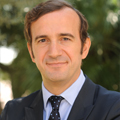Big data, social media and other information technologies are a manifestation of a new concept that we call digital density, says IESE Professor Javier Zamora. This refers to the number of people and objects that are connected, and which now number in the billions. Digital density allows for a dynamic use of capacity that wasn’t feasible before, but taking advantage of this calls for new business models.
Transcription
Many managers are taking about “I need a strategy in mobility”, “I need a strategy in social media”, “I need a strategy in cloud computing”, and “how are we going to jump on the bandwagon of Big Data?”. But instead of trying to look separately at all these technologies, I think these technologies are basically the manifestations of another concept that’s what we call the digital density. We define it as the number of connections, permanent connections, to the internet by people, employees, providers, clients and objects. And in recent years this digital density has exponentially grown from hundreds of millions of computers connected to the internet, to billions of computers, smartphones, tablets and sensors.
For instance, in the past, the organizational chart was very clear – who’s your boss, who’s reporting to you. But we see for instance, like in Linkedin, it reflects our professional graph. We see that the number of interactions is beyond the organizational chart. And this is because of the increase of digital density. Because right now the cost of these connections with these people is basically very low allowing new things and interactions inside organizations.
So the difference between online and offline was very clear until recently. But let’s think of another company that is quite modern, Groupon. Groupon in the past was doing offers to the clients using email. You have a new offer for a restaurant or for a hotel. But now Groupon is going beyond and taking advantage of digital density because now the customers have a mobile phone and imagine a customer walking around the city and at some moment that customer is hungry. So right now, using Groupon now, basically he’s saying, “OK, I want to eat here”. All the providers that subscribe to Groupon now, they can make offers dynamically to that client. So digital density allows a dynamic allocation of capacity that maybe that restaurant isn’t using for a given moment. Something that in the past was not feasible. We see that we have an impact on business models, and also we have an impact on organizations. But this becomes what we call the Virtual Circle of digital transformation. Changing the business model is going to require change in our organization. The changes in the organization are going to allow the addressing of new business models.


